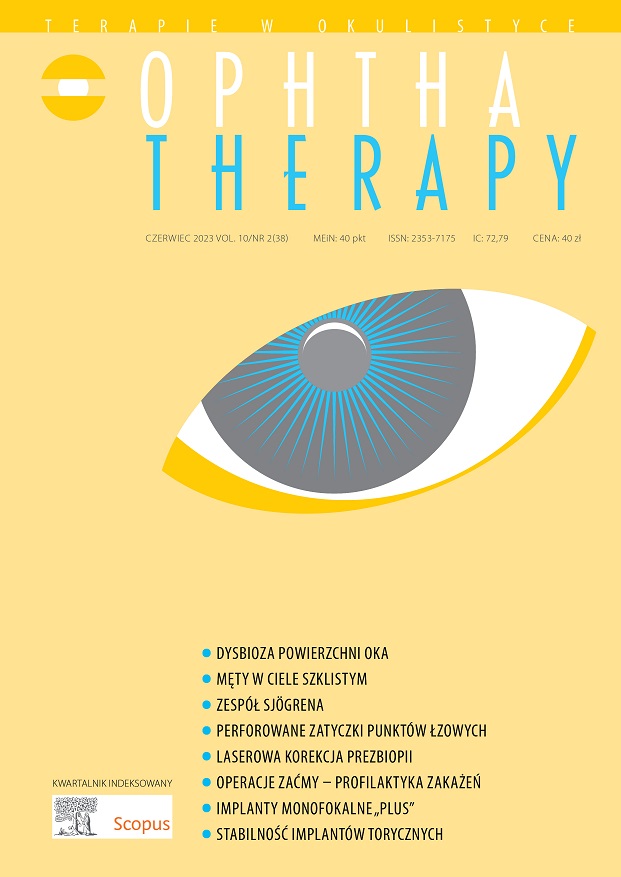Wpływ laserowej korekcji starczowzroczności metodą Presbyond® Laser Blended Vision (LBV) na poczucie kontrastu Artykuł przeglądowy
##plugins.themes.bootstrap3.article.main##
Abstrakt
Metoda Presbyond® Laser Blended Vision (LBV), oparta na technice zabiegu FemtoLASIK, jest obecnie najczęściej wykonywaną laserową procedurą refrakcyjną mającą za cel korekcję starczowzroczności. Metoda ta polega na nieliniowej asferycznej ablacji rogówki i kontrolowanym wyindukowaniu aberracji sferycznych w obojgu oczach oraz wytworzeniu mikromonowizji od -0,75 do -1,50 D w oku niedominującym. W artykule przedstawiono wyniki opublikowanych prac analizujących wpływ laserowej korekcji starczowzroczności metodą Presbyond® LBV na poczucie kontrastu. Dotychczasowe badania wskazują, że zabieg Presbyond® LBV nie wpływa istotnie na czułość na kontrast.
Pobrania
##plugins.themes.bootstrap3.article.details##

Utwór dostępny jest na licencji Creative Commons Uznanie autorstwa – Użycie niekomercyjne – Bez utworów zależnych 4.0 Międzynarodowe.
Copyright: © Medical Education sp. z o.o. License allowing third parties to copy and redistribute the material in any medium or format and to remix, transform, and build upon the material, provided the original work is properly cited and states its license.
Address reprint requests to: Medical Education, Marcin Kuźma (marcin.kuzma@mededu.pl)
Bibliografia
2. WHO. Vision 2020. Global initiative for the elimination of avoidable blindness. Fact Sheet No 1213. Geneva: WHO, 2000.
3. Reilly CD, Lee WB, Alvarenga L et al. Surgical monovision and monovision reversal in LASIK. Cornea. 2006; 25(2): 136-8. http://doi.org/10.1097/01.ico.0000178722.19317.7b.
4. Levinger E, Trivizki O, Pokroy R et al. Monovision surgery in myopic presbyopes: visual function and satisfaction. Optom Vis Sci. 2013; 90(10): 1092-7. http://doi.org/10.1097/OPX.0000000000000002.
5. Garcia-Gonzalez M, Teus MA, Hernandez-Verdejo JL. Visual outcomes of LASIK-induced monovision in myopic patients with presbyopia. Am J Ophthalmol. 2010; 150(3): 381-6. http://doi.org/10.1016/j.ajo.2010.03.022.
6. Reinstein DZ, Couch DG, Archer TJ. LASIK for hyperopic astigmatism and presbyopia using micro-monovision with the Carl Zeiss Meditec MEL80 platform. J Refract Surg. 2009; 25(1): 37-58. http://doi.org/10.3928/1081597X-20090101-07.
7. Rocha KM, Vabre L, Chateau N et al. Expanding depth of focus by modifying higher-order aberrations induced by an adaptive optics visual simulator. J Cataract Refract Surg. 2009; 35(11): 1885-92. http://doi.org/10.1016/j.jcrs.2009.05.059.
8. Montés-Micó R, Charman WN. Mesopic contrast sensitivity function after excimer laser photorefractive keratectomy. J Refract Surg. 2002; 18(1): 9-13. http://doi.org/10.3928/1081-597X-20020101-01.
9. Lackner B, Pieh S, Funovics MA et al. Influence of spectacle-related changes in retinal image size on contrast sensitivity function after laser in situ keratomileusis. J Cataract Refract Surg. 2004; 30(3): 626-32. http://doi.org/10.1016/j.jcrs.2003.08.032.
10. Elliott DB. Contrast sensitivity decline with ageing: a neural or optical phenomenon? Ophthalmic Physiol Opt. 1987; 7(4): 415-9.
11. Nomura H, Ando F, Niino N et al. Age-related change in contrast sensitivity among Japanese adults. Jpn J Ophthalmol. 2003; 47(3): 299-303. http://doi.org/10.1016/s0021-5155(03)00011-x.
12. Datta S, Foss AJ, Grainge MJ et al. The importance of acuity, stereopsis, and contrast sensitivity for health-related quality of life in elderly women with cataracts. Invest Ophthalmol Vis Sci. 2008; 49(1): 1-6. http://doi.org/10.1167/iovs.06-1073.
13. Reinstein DZ, Archer TJ, Gobbe M. LASIK for Myopic Astigmatism and Presbyopia Using Non-Linear Aspheric Micro-Monovision with the Carl Zeiss Meditec MEL 80 Platform. J Refract Surg. 2011; 27(1): 23-37. http://doi.org/10.3928/1081597X-20100212-04.
14. Reinstein DZ, Carp GI, Archer TJ et al. LASIK for presbyopia correction in emmetropic patients using aspheric ablation profiles and a micro-monovision protocol with the Carl Zeiss Meditec MEL 80 and VisuMax. J Refract Surg. 2012; 28(8): 531-41. http://doi.org/10.3928/1081597X-20120723-01.
15. Reinstein DZ, Ivory E, Chorley A et al. PRESBYOND Laser Blended Vision LASIK in Commercial and Military Pilots Requiring Class 1 Medical Certification. J Refract Surg. 2023; 39(1): 6-14. http://doi.org/10.3928/1081597X-20221129-02.
16. Lim DH, Chung ES, Kim MJ et al. Visual quality assessment after presbyopic laser in-situ keratomileusis. Int J Ophthalmol. 2018; 11(3): 462-9. http://doi.org/10.18240/ijo.2018.03.17.
17. Zhang T, Sun Y, Weng S et al. Aspheric Micro-monovision LASIK in Correction of Presbyopia and Myopic Astigmatism: Early Clinical Outcomes in a Chinese Population. J Refract Surg. 2016; 32(10): 680-5. http://doi.org/10.3928/1081597X-20160628-01.
18. Brar S, Sute SS, Bagare SN et al. Functional Outcomes and Reading Speeds following PRESBYOND LBV Using Nonlinear Aspheric Ablation Profiles Combined with Micro-Monovision. J Ophthalmol. 2021; 2021: 2957443. http://doi.org/10.1155/2021/2957443.
19. Romero M, Castillo A, Carmona D at al. Visual quality after presbyopia correction with excimer laser ablation using micromonovision and modulation of spherical aberration. J Cataract Refract Surg. 2019; 45(4): 457-64. http://doi.org/10.1016/j.jcrs.2018.10.048.

